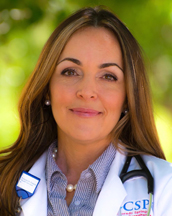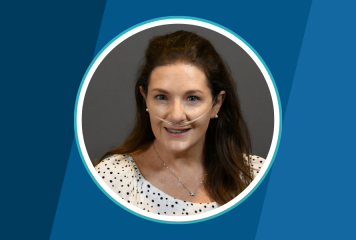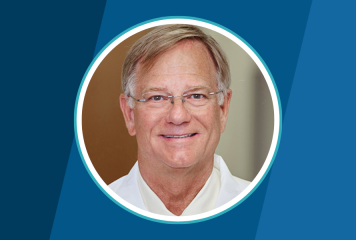
Corinne R. Young, MSN, FNP-C, FCCP, is a pulmonary disease specialist as well as founder and President of the Association of Pulmonary Advanced Practice Providers (APAPP), a community for nurse practitioners and physician assistants working in pulmonary, critical care, and sleep medicine. She is one of the first ten advanced practice providers nationwide to become a fellow of the American College of Chest Physicians (CHEST) and serves on the CHEST Physician Magazine editorial board. Ms. Young has served as a member of the ABIM Pulmonary Disease Board since 2018.
You began your career as an ICU nurse. What inspired you to specialize in pulmonary care?
It’s a funny story. I worked in critical care as a nurse and I was exposed to intensivists, who are usually pulmonologists also. One of them kept offering me a job and I said no, because I was getting board certified in family practice. He said, “I have a multi-specialty group with a family practice side.” So I joined but he kept inviting me to see his pulmonary patients and after two years I realized I was only seeing pulmonary patients, so he’d gotten his way. I found out that I loved it. One reason I was deterred was because there’s no board certification in pulmonary for advanced practice providers (APPs) and there’s no nationally recognized fellowship post-graduate program for us either, so I felt like I’d be a fish out of water. I did what most APPs do, which was on-the-job training. Eighteen years later I’m still here.
You also hold the distinction of being one of the first ten advanced practice providers in the country to become a fellow of CHEST. What does that recognition mean to you personally and professionally?
It means everything because it’s currently the only designation that vets my experience in pulmonary medicine as a provider. There is no certification for APPs, so for CHEST to offer that to other allied health professionals was another opportunity for me to say I’m in this field and it’s not a pretend position—I’m recognized by someone.
What led to the creation of the Association of Pulmonary Advanced Practice Providers? What achievement(s) of the APAPP are you most proud of?
Pulmonary and sleep medicine APPs have been out here working for decades without the support of an organization just for them. Having an organization helps develop standards of practice and provides networking and job opportunities. We hope that one day we can grow to a position of offering a board certification so we can say, “Here is the standard education of a pulmonary APP.” But that starts with organizing and bringing everyone together.
When you’re learning on the job, you’re at the mercy of your employer and what they give you education-wise, or you’re at the mercy of your own learning. ABIM has published a lot about the disadvantages and impact of health care providers not being held to a standard—we don’t know what we don’t know. It’s more concerning in our area because we don’t go through a fellowship. We’re doing it all at once: we’re learning as we go and it can be like drinking from a firehose. The physicians we work with expect us to know what they know and do what they do, manage patients the way they do. It’s a precarious position to be in, which is why our organization became what it is. We’re trying to provide educational resources and a hub for APPs to learn and be the best they can be in the specialty.
There’s a lot that I’m proud of. We’ve participated in a couple million dollars’ worth of education grants providing continuing medical education grants to our members. In May, we released “The APAPP Podcast” to expand our network of learning opportunities for our members. I’m proud that we’re growing the membership in general. My heart is the fullest when I get to interact with other members who say things like, “Where have you been my whole career? I’ve been looking for something like this, I’m so excited to find you.” A lot of our members felt isolated because they don’t know what resources to tap into; now because of APAPP there’s someone to compare themselves against and talk through how many patients they’re seeing, how they’re billing. We’re trying to help develop standards.
Why is it important to you to promote the involvement and representation of advanced practice providers in the pulmonary world? What impact do you hope to achieve through your work in this area?
The demand for skilled, knowledgeable providers is growing. We know that the rate at which physicians are retiring versus the number of pulmonologists completing fellowship programs is going to leave a gap. Patients are still going to need care and that’s where APPs come in. We’re not here to replace physicians but rather be the glue to help hold everything together and get patients care. Not only do we want to help with this health care concern, we want to provide exceptional care in this area and be helpful partners in medicine. APAPP is trying to be a hub and a beacon to draw APPs to a higher level of learning so that great care can be provided.
How does your involvement with CHEST—both through the editorial board and education and community networks—contribute to your goals and vision for the field of pulmonary medicine?
CHEST has been our biggest public supporter. Their values around education and the collaboration of the health care team have been inspirational for us. Back in 2012/2013, when I first joined CHEST, I thought I’d come with this novel idea of APP inclusion. I was so impressed to find they’d already started a roadmap of new ways to engage and involve APPs. I am honored to be involved in the CHEST Physician Editorial Board and provide an APP perspective. They’re so inclusionary of the health care community.
In your role on the CHEST Physician Editorial Board, how do you raise awareness among clinicians about the crucial role of APPs in the care team? How can high-quality education and content support APPs in enhancing the care they deliver?
The editorial board has given us a platform to engage readers and the feedback I’ve gotten has been positive: physicians are engaging. It’s becoming more of the standard and less of the exception that pulmonologists are working with APPs on the job. From the beginning of my career to what it is now, it is very rare that I come in contact with a physician who is not working with at least one APP in their practice. Now having a little more of a voice in CHEST Physician is naturally the next step to that whole health care team approach and the discussion of disease management in patients.
As a consultant for clinical trials, how do you see research contributing to advancements in pulmonary medicine? Can you share any notable experiences or discoveries from your involvement?
Medicine is evolving at an exponential rate. Involvement in trials opens opportunities for us to keep on the cutting edge and not just be a spectator looking at papers; we actually get to take part and see how the industry is approaching patients and diseases. It’s a great opportunity, especially for small practices. There are a lot of times patients want to get involved in a trial and have to travel to a large city. For individual community practices our patients were very eager and excited to be involved.
Now when I read a research article on a Phase II or III study, I have a much deeper understanding of that data and how they were collected, and what was asked of those patients. I was so impressed by how generous our patients were with their time and their condition. They wanted to help us understand their disease and contribute to helping future patients. They said they wanted to help the future person in their shoes even knowing they may not see the benefit themselves. I am so impressed with how giving these sick patients are; it really gives you a little hope for humanity.
Why did you want to serve on the ABIM Pulmonary Disease Board? What has been valuable about this experience for you?
I felt it was an amazing opportunity to provide an APP perspective and I’m honored that ABIM would even want that. It’s very forward-thinking of the organization. It was also a great opportunity to be a fly on the wall as APAPP grows, surrounding ourselves with giants in specialty certification—like ABIM—and education—like CHEST. Iron sharpens iron and it’s great to be around these legendary organizations and learn from them.
What do you do for fun?
Team roping. It’s a rodeo sport and timed event where there is a team consisting of two ropers (a header and a healer) and one steer. I’m a header. The steer gets a head start and I have to rope its horns, then turn it left so that the healer can rope two feet. Once the steer is roped, the clock stops and the fastest team wins. The sport originated in the 1800s when American cattlemen would need to catch cattle to tag or doctor. My husband and I compete as a team and last year we qualified for the world series of team roping in Las Vegas.



